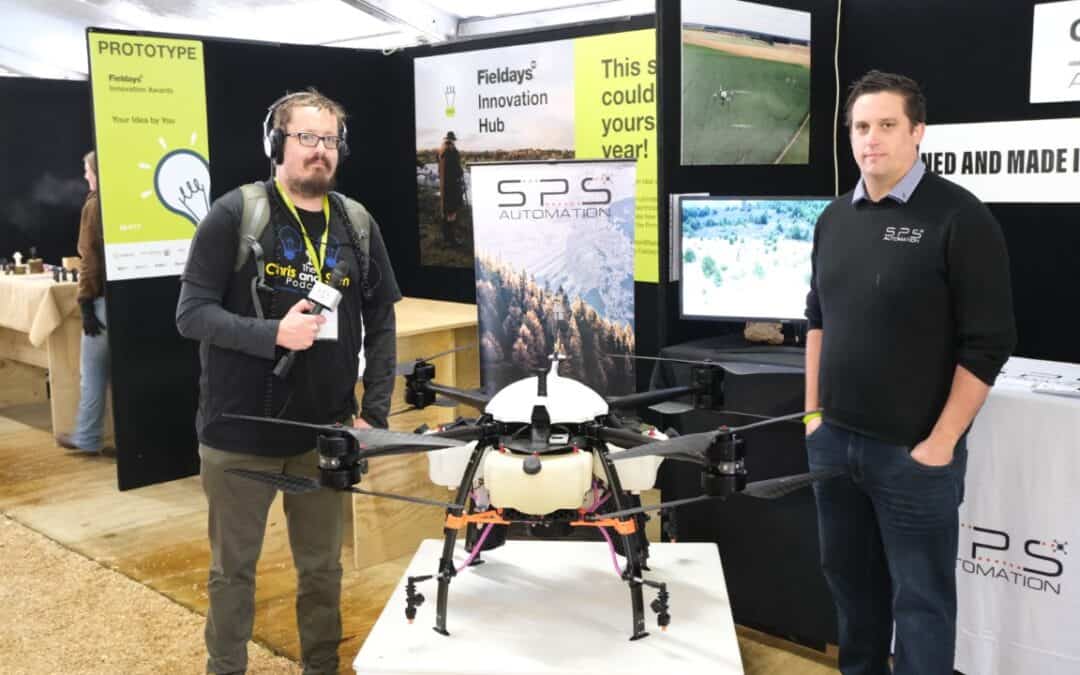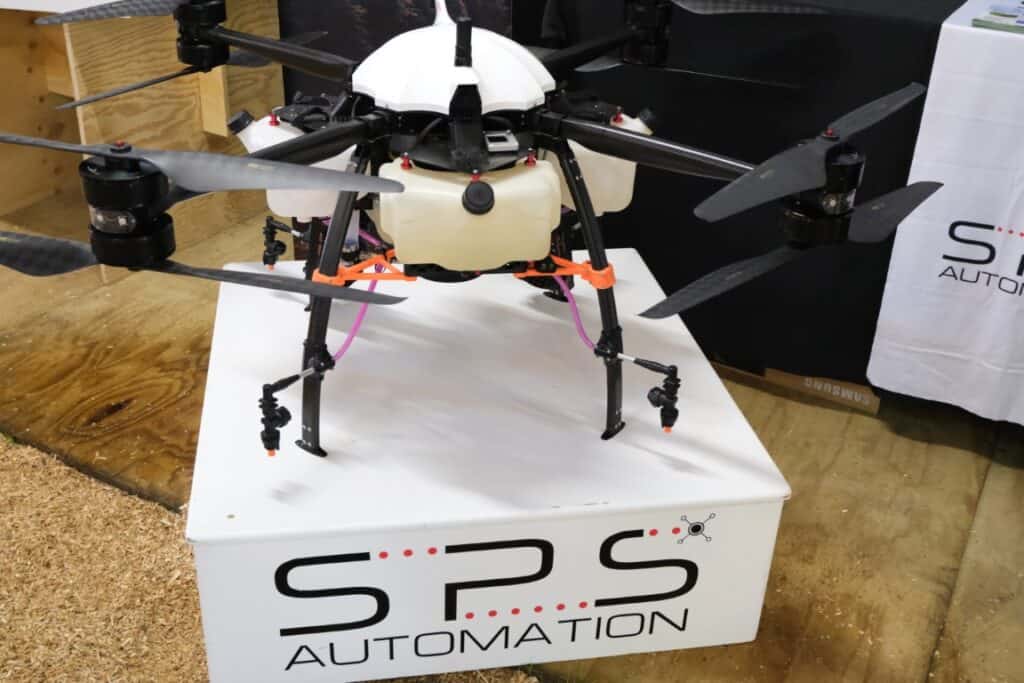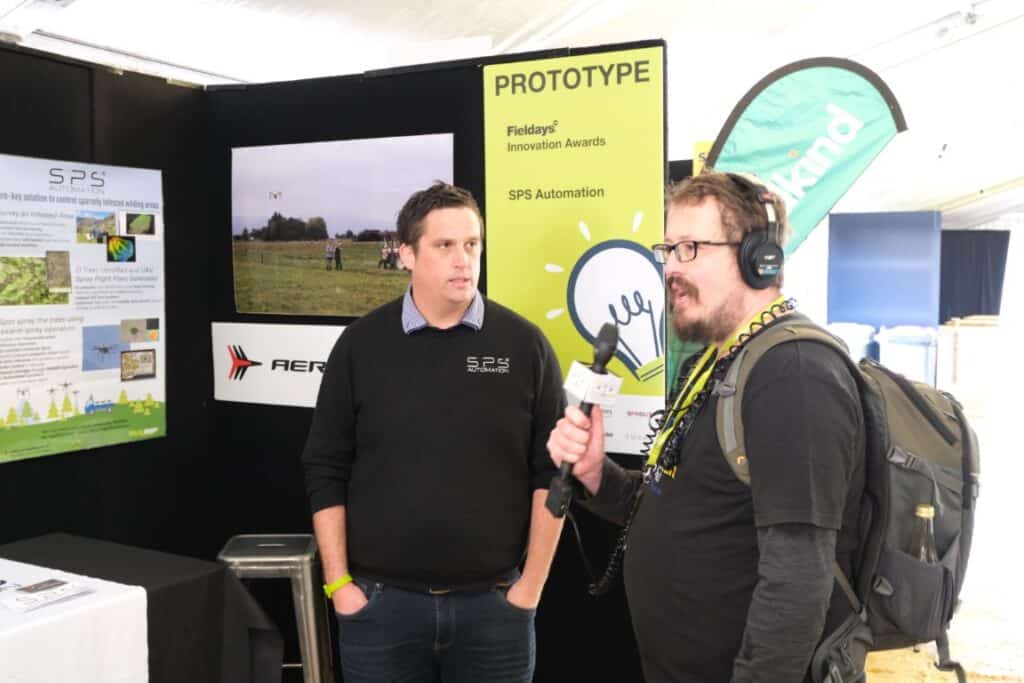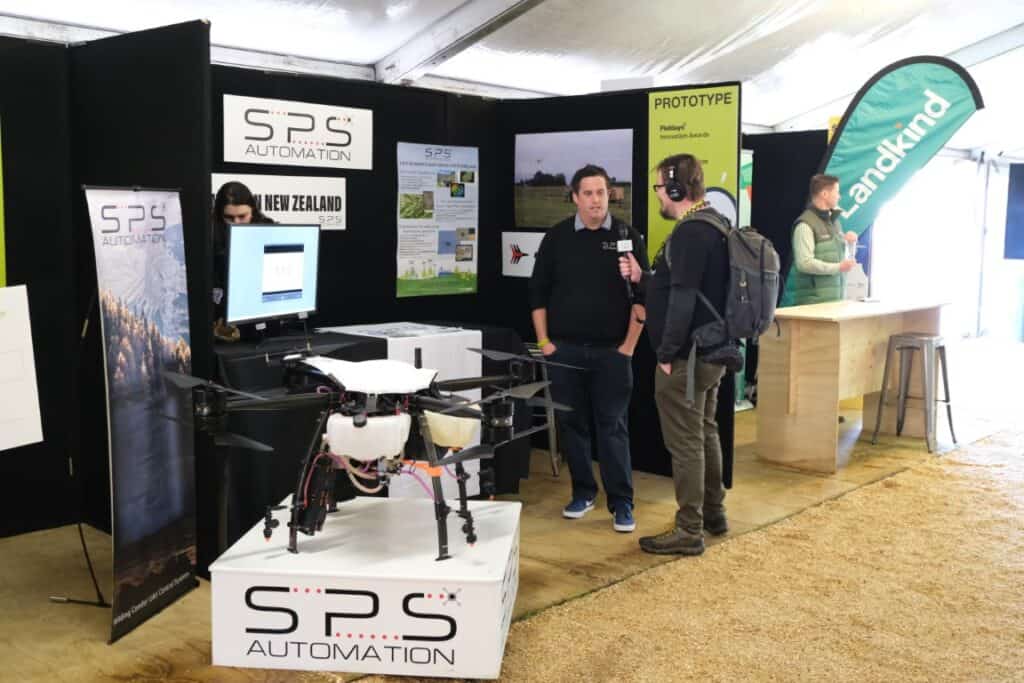Summary
Sam talks to Scott from SPS Automation to find out what their purpose built drone can do to help combat weeds in forestry situations.
Built from the ground up in Christchurch, this is some impressive technology.
Links
Photos
Show Transcript
This transcript was generated by an AI and may not be 100% accurate. If you have questions about any of the information found here, please reach out to us.
Sam [00:00:21]:
Hey, guys, here I am at the Innovation tent at Field is 2023. I am with SPS automation and I’m with
Sam [00:00:29]:
Scott Spooner.
Sam [00:00:31]:
Scott Spooner. Now, he’s got a big ass drone here and we caught a little bit of him telling some farmers what this thing can do. And it sounds very interesting.
Scott [00:00:41]:
Yeah. So we’ve developed a spot spraying system for targeting invasive plants in New Zealand. This machine will actually go out, identify the plants, work out the size of each one, and then spray a targeted chemical dose.
Sam [00:00:55]:
Now that is amazing when you think about it. We’ll gave a photo of the drone, but it’s a big unit to identify the plant and the size and then spray it. That has to be such a time saving use of technology.
Scott [00:01:11]:
Yes, and we’ve also solved one of the other major issues that they have with spray drones. That is the fact that most spray drones run on batteries and they’re very restricted in their flight time. Even the market leaders can only fly for around ten minutes. But this machine is hybrid, so it actually runs on fuel and we can fly it for 40 minutes up to 2 hours.
Sam [00:01:30]:
Well, that’s very impressive. And yeah, like you said, most of the other drones are limited by their flight time, which sort of limits its use, I guess.
Speaker D [00:01:41]:
Yes.
Scott [00:01:41]:
Well, when you’re spot spraying, one of the major challenges we’ve faced is you’ve actually got to carry the chemical with you to all the different locations so that by being able to fly for an extended amount of time, we can actually deliver these chemicals in remote areas.
Sam [00:01:55]:
And the first question I sort of was thinking about is this unit built on an existing frame?
Speaker D [00:02:03]:
No.
Scott [00:02:04]:
So everything, including the drone and all the technology, is designed and built right here in New Zealand.
Speaker E [00:02:09]:
Well, that’s cool.
Sam [00:02:10]:
And how long has it taken from idea to development to what we’re seeing here?
Scott [00:02:16]:
So we’ve been working on this project for around three years. The majority of the work is in the software infrastructure in order to do the automatic detection of the trees or different plants. The actual hardware itself is probably about a year’s worth of work to get it to the stage.
Sam [00:02:33]:
That’s cool.
Sam [00:02:34]:
Whereabouts are you guys based in New Zealand?
Scott [00:02:36]:
So we’re based in Christchurch and we do also do bespoke robotics. So concept to commercialization for people who have interesting ideas.
Sam [00:02:46]:
That sounds very cool. What other things have you been working on then in the past?
Scott [00:02:50]:
So we do a lot of drone based robotics and taking aircraft to do really bespoke tasks across a variety of things. We also do ground based robots, so warehouse robots that might move around in factories or in big facilities. We’ve been making some stuff for the meatworks industry. We’ve been developing a lot of different sensor based AI for different robotic applications. So basically anything that moves and needs to think is something that we can design and build.
Sam [00:03:25]:
So what I’m hearing is if I want a Terminator type machine to work inside a factory, you guys are the people to talk to.
Scott [00:03:31]:
Well, we don’t actually build anything that would be what you class as offensive, but yes, if you wanted a worker, then we could build that.
Speaker E [00:03:44]:
Excellent.
Sam [00:03:44]:
You got any questions there, Chris?
Sam [00:03:53]:
And I’m assuming this indoor rain that we have here at Innovation Tent isn’t causing any problems with this machine?
Scott [00:03:58]:
No, it’s waterproof. After we finish the spray job, we actually just hose it down.
Speaker E [00:04:03]:
Oh, that’s cool.
Sam [00:04:04]:
And what’s the feedback been like for the people you’ve spoken to already here and obviously other places around the country.
Scott [00:04:11]:
It’S been really positive. So one of the key players in the industry is the forestry is forestry. We can do things like pre plant release spraying as well as maintaining weed control in the areas.
Sam [00:04:25]:
Yeah, I see on your video here you’ve got a bit of spray stuff going on with the drone. And I was just thinking about that because way back in the day, I used to do forestry checks randomly and we had to check on thinning and spraying and things like that. So getting into some of those remote areas with something as simple as this must save a lot of time and effort.
Scott [00:04:47]:
Yeah, well, we could actually fully remotely operate this, so I could fly this here in Hamilton from our offices in Christchurch, and the aircraft actually work in what we call swarm. So single operator in the field with up to ten aircraft operating simultaneously, and we can fully remotely monitor all of the health of the aircraft, what they’re doing, where they are and how it’s working.
Speaker E [00:05:10]:
That’s pretty cool.
Sam [00:05:11]:
So Sam technology is sort of like the little drones when they do the light shows. Similar. I guess. I guess I’ll end with this. What’s been the biggest hurdle for you in coming up with this drone?
Scott [00:05:23]:
Well, there’s been quite a few challenges, especially when the technology that you need to build doesn’t exist. So we developed all the algorithms, all the flight systems for it. There was a few, I guess you’d say, exciting moments. But we got there at the end and our machine now works and we’re sort of ready to start rolling it out.
Speaker E [00:05:44]:
Awesome.
Sam [00:05:44]:
So next step, obviously, this is designed and made in New Zealand. Will you be trying to roll this out in other countries, other places around the world?
Speaker D [00:05:52]:
Yes.
Scott [00:05:52]:
So we’re sort of focusing on New Zealand to start with. The wilding pine issue is a massive problem in the South Island, and that is a big target for us. But we are also doing gorse nacellotasic other invasive plants, introducing them into our algorithms that detect them. But once we’ve sort of got it now here we’ll roll it out across the world.
Sam [00:06:11]:
That’s very cool.
Sam [00:06:13]:
Great technology, great set. Designed and made in New Zealand. You can definitely see the benefit of this big ass drone.
Speaker E [00:06:21]:
It’s great.
Sam [00:06:22]:
So thank you so much for talking to us.
Speaker E [00:06:24]:
Awesome.
Speaker D [00:06:24]:
Yeah.
Sam [00:06:25]:
One last question.
Speaker D [00:06:26]:
Do you listen to podcasts?
Sam [00:06:27]:
And if you do, do you have any recommendations?
Scott [00:06:32]:
I do listen to some podcasts. Probably the last one I was listening to. It’s pretty boring. It was about new LiDAR technology that’s coming out.
Sam [00:06:43]:
But no, that’s fine. We love hearing about all these different podcast. It’s amazing.
Scott [00:06:48]:
What’s up technology stuff. As the CTO, I have to keep up to date with any new technology that’s coming on the market and whether we can integrate that into our system.
Speaker E [00:06:56]:
Just to follow up on that.
Sam [00:06:57]:
Then what do you see as coming up? Technology that you may want to look.
Scott [00:07:02]:
At so upcoming, just in general or.
Sam [00:07:05]:
From us in general, that could impact what you’re doing here.
Scott [00:07:10]:
So the introduction of new sort of UTM or like airspace awareness systems that allow us to operate remotely in areas would be really great. Managing the difficulties with AG sprayers, if we are operating autonomously in the middle of nowhere and a helicopter rips through, we need to manage those risk cases. So there is a number of technologies that are coming out and also stuff that we are developing for that all rather exciting.
Sam [00:07:40]:
SPS automation. Thank you so much for talking to us here at Field Days.
Scott [00:07:45]:
Yeah, it’s spssautomation.com, nice and simple.
Sam [00:07:49]:
Check it out and we’ll have some photos on our show notes.
Speaker E [00:07:52]:
Cool, thanks.
Be Social with Us
Support the Podcast and Become a Super Fan
The Chris and Sam Podcast Facebook Page
Visit us on Instagram
The Chris and Sam Podcast Twitter Feed
Chris’s Website
Sam’s Website




